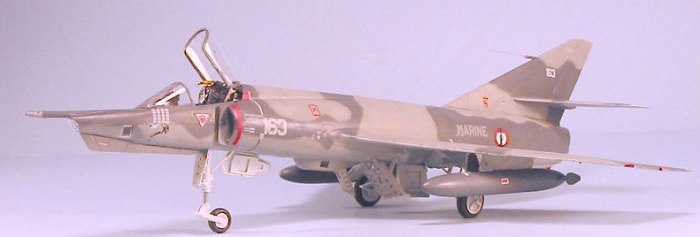
Airfix 1/48 Etendard IVP
| KIT #: | 80412 |
| PRICE: | $ Currently(2004) OOP |
| DECALS: | Two options |
| REVIEWER: | Tom Cleaver |
| NOTES: | Also can be found in Heller boxes. |

| HISTORY |
During the Korean War, the Armée de l’Air initiated a development program in December 1953 to create a lightweight jet interceptor, which resulted in the Breguet Br. 1000 and the Dassault Mystère XXII. Both featured the use of two Turboméca Gabizo engines for power. Shortly after these prototypes were selected by the Armée de l'Air, General Lauris Norstad, NATO Commander in Chief, issued a bid in April 1954 for what became known as the Light Weight Tactical Strike Fighter program. The aircraft was have the ability to defend NATO airbases, and then be able to operate from damaged airfields to attack the USSR.
The first Dassault
Mystère XXII was renamed Étendard II just before its first
flight on July 23rd 1956 at Melun-Villaroche. The aircraft featured a
fuselage inspired by that of the MD-550 Mirage I, with a 45°swept
wing similar to that of the Super-Mystère B2. It was to be fitted
with two SNECMA R-105 engines, but was powered by two Turboméca Gabizo
engines. It was equipped with two 30mm canons on an internal frame easy to
remove for maintenance, and a Matra rocket launcher in a weapons bay. The
Étendard II was to be able to exceed Mach 1 in a dive and to reach
10,000 meters in less than 6 minutes. Mach 1 was never reached even in a
dive, and the Étendard II took 12 minutes to reach 10,000 meters.
The program was halted and the construction of the second prototype was
abandoned in November 1956.
 On July 24th 1956, the day following the
Étendard II's
first flight, a second plane - designated Étendard IV - took flight
at Bordeaux-Mérignac. Though it looked like an Étendard II, it was
in fact 15% larger, and was powered by a single SNECMA Atar 101E
engine.
On July 24th 1956, the day following the
Étendard II's
first flight, a second plane - designated Étendard IV - took flight
at Bordeaux-Mérignac. Though it looked like an Étendard II, it was
in fact 15% larger, and was powered by a single SNECMA Atar 101E
engine.
The Étendard IV
turned out to have brilliant performance, beating a Mystère IV -
then the main interceptor in the Armée de l'Air - in aerial combat.
Additionally, it looked like a good contestant for the NATO LWTSF
competition. However, the LWTSF specification required the adoption of a
Bristol Orpheus 12 engine, which was inferior to the Atar since it lacked
an afterburner. The special Étendard with the Orpheus engine became
known as the Étendard VI.
The LWTSF consulting committee presided over by Theodore Von
Karman chose three projects: the Fiat G.91, the Breguet Br.1001
Taon
and the AMD Étendard VI, each fitted with the Bristol Orpheus 3 and
armed with two 30mm cannon and four 12.7mm machine guns. The selection
tests were held at the Bretigny-en-Orge Centre d'Essais en Vol
September 16th-October 4th, 1957. The Étendard VI was eliminated,
and the Fiat G.91 was eventually chosen in the beginning of 1958.
With its outstanding performance, a naval version of the Étendard IV had already been considered by Dassault, and provisions had been made to navalize the plane by adding folding wings, arrester gear and fuselage strengthening. On January 14, 1955, the Aeronautical Technical Service asked Dassault to study the possibility of navalizing the plane as a multi-role attack and low altitude fighter. On December 19, 1956, the Navy announced an order for the prototype Étendard IVM, as an attack and medium/low altitude interceptor, fitted with a SNECMA Atar 8, to be based on the new aircraft carriers Clemenceau and Foch then in construction. Five pre-production aircraft were ordered in May 1957.
The Étendard IVM
was modified from the earlier aircraft with changes to the plane’s
aerodynamics according to the "area rule" and increasing the wing area to
compensate for the increase in total weight, along with reinforcement of
the airframe for catapulting (3 to 5.5g) and deck landing (3g).
The Aéronautique Navale also demanded that the
Étendard
IVM be able to refuel in-flight from another Étendard. The solution
adopted was a Douglas “buddy” type under fuselage tank with the
probe-and-drogue refueling system.
Étendard IVM
01 took flight on May 21, 1958, at Melun-Villaroche. Fitting a fin under
the nose, which would also house ECM antennas, solved problems that had
appeared during spin trials in a wind tunnel. The first land-based catapult
and deck-landing trials were held at Bedford's Royal Aircraft Establishment
in the UK in November and December 1958. Trials at sea took place off Cap
de la Chèvre near Brest. Étendard IVM 02 performed the first deck
landing aboard the Clemenceau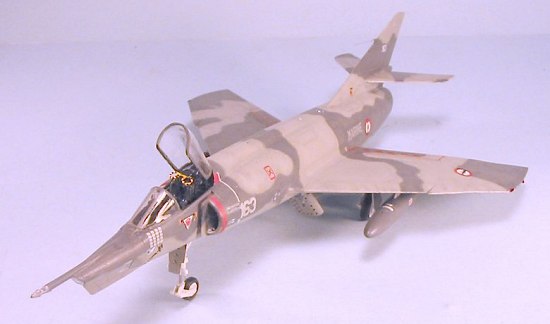 on September 19, 1960, and the first
production aircraft flew on July 16, 1961, at Mérignac.
on September 19, 1960, and the first
production aircraft flew on July 16, 1961, at Mérignac.
Squadron 15.F deactivated its Chance-Vought F4U-7 Corsairs on February 1, 1962. The unit was reactivated on June 1, 1962 with its new Étendard IVMs, at NAS Hyères on the Riviera. This unit eventually became the Étendard OCU, with the operational squadrons being 11.F and 17.F.
The Étendard IVP photo reconnaissance type was ordered in September 1959, and made its first flight on November 19, 1960.
The Étendard IVP entered service with Squadron 16.F in 1964. From March to December 1966, Squadron 15.F was chosen to participate with the Foch to the Alpha mission in the Pacific, the first French nuclear tests in Polynesia. A detachment of Étendard IVPs from 16.F squadron also participated in this operation.
In April 1969 Squadron 16.F followed the other attack units to the new base, NAS Landivisiau. After two years spent increasing the photo-recon technology of the Étendard IVP the squadron beat its traps record by performing 494 carrier landings in a single year during 1972. The following year saw the introduction of color photography.
By 1977, 11 of the
24 photo-recon aircraft had been lost. Since the Super
Étendard
would not be produced in a photo-recon version, it was decided to modify
the surviving Étendard IVM aircraft to become the
Étendard IVPM.
This modification work started on December 12, 1977, and was completed by
1977. Only those Étendard IVM aircraft that could use the Douglas
buddy refueling system were so modified. Squadron 11.F was reactivated to
operate the Étendard IVPM. The
Étendard IVPM looked exactly
like a production IVP, except that the outer wings lacked the BW
warning receiver on the IVPM.
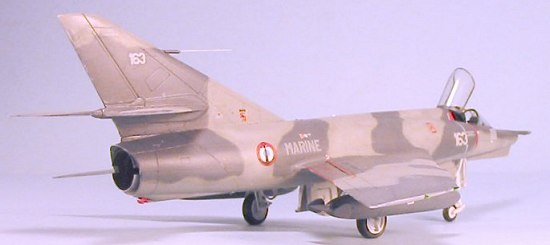 After Squadron 11.F traded in its
Étendard IVMs for
brand new Super-Étendards in 1978, Squadron 16.F was given two
Etendard IVMs which were quickly replaced by two IVPMs. In 1980, the
squadron made five cruises on the two carriers. In 1983 several
detachments went aboard the Foch and the
Clemenceau for
missions Olifant XIII, XVII, XVIII and XIX off the Lebanese coast.
Twenty-nine sorties were flown in thirteen combat missions. A plane from
16.F was hit by a SAM, but managed to return to the ship. Another plane
went on a photo run to obtain a bomb damage assessment after a
Super-Étendard
raid on Baalbeck in retaliation for the bombing of the French "Drakkar"
barracks in Beirut.
After Squadron 11.F traded in its
Étendard IVMs for
brand new Super-Étendards in 1978, Squadron 16.F was given two
Etendard IVMs which were quickly replaced by two IVPMs. In 1980, the
squadron made five cruises on the two carriers. In 1983 several
detachments went aboard the Foch and the
Clemenceau for
missions Olifant XIII, XVII, XVIII and XIX off the Lebanese coast.
Twenty-nine sorties were flown in thirteen combat missions. A plane from
16.F was hit by a SAM, but managed to return to the ship. Another plane
went on a photo run to obtain a bomb damage assessment after a
Super-Étendard
raid on Baalbeck in retaliation for the bombing of the French "Drakkar"
barracks in Beirut.
From January 28-March 15th 1993, the unit was part of the first Balbuzard mission over Yugoslavia with three Étendard IVPMs from the Clemenceau. The Foch left for the Adriatic between July and August 1993. The Clemenceau took over the missions and made its third cruise in the Adriatic from September 2nd to October 15th with four Étendard IVPMs. By September 18th, some 64 tactical recce sorties had been flown for the “Sharp Guard” missions.
From March 24-May 3,1994, the Clemenceau replaced its sister ship for the fourth Balbuzard mission. On April 15, Étendard IVPM No. 115 was hit by a SAM during a photo run over Gorazde. The pilot, CC Clary - 16.F CO - managed to return to the ship despite the plane being very badly damaged.
The last Étendard
IVPM combat mission was during Operation Trident between January
and June 1999, aboard the Foch for operations over Kosovo. The four
detached Étendard IVPMs flew 58 recon missions. On June 27th 2000,
Étendard IVPM No. 115, flown by CC Philippe Goetz, made the last
launch from the Foch during the carrier's last cruise. On July 27th
2000, squadron 16.F, the fleet's sole photo recce squadron, and the last
unit to fly the Étendard IVPM, was officially shut down at NAS
Landivisiau.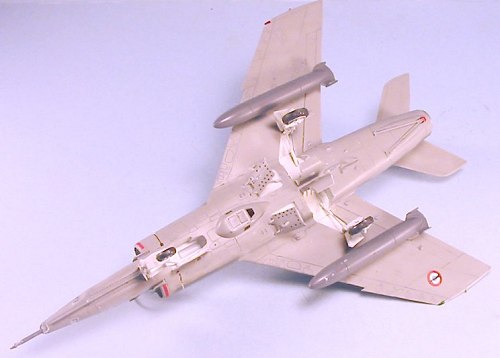
Perhaps the best compliment the airplane ever got that I am aware of was the admission by a very senior retired American Naval aviator, a man who had been a MiG-killer in Vietnam, that the one time he ever was in serious trouble in air-to-air combat was the day he had his F-8J’s tail feathers waxed by a French pilot in an Étendard back in the early 1970s. As far as he was concerned, the little Étendard was the best lightweight naval fighter he’d ever run across.
| THE KIT |
While the name on the box of the kit I received from my friend Andy Abshier said “Airfix,” I am reliably informed that this is a Heller kit from the late 1980s. Opening it up, one is immediately aware of how far limited-run kits have come, and how sad it is that Airfix/Heller has been run by bean-counters for the past 20 years. The molding of the kit isn’t up to current standards in injection-molded kits from Eduard, Roden, Sword or MPM. There was more than a bit of flash on many parts, and not one part that didn’t need to be cleaned up to proceed with construction. That said, the kit is accurate in outline and in what detail is provided.
The decals are only of value by the fact there are no alternatives available, since they are just misaligned enough in printing for it to be visible and unfixable. The decals provided are for one of the last operational Etendards flying off “Foch” during the Kosovo Crisis in 1999.
| CONSTRUCTION |
I began construction
with the wings. By carefully cleaning up the lower surface insert part and
carefully aligning it to the upper wing part, I was able to flood the
forward seam with enough Ambroid Pro-Weld to get it looking good without
having to further putty or sand the area. This was important, since there
were a number of engraved panels on the leading edge of the
 wing.
Test-fitting the separate flap showed it fit poorly either up or down.
Given that the additional part that slides out when the flap is lowered -
and is very visible in that configuration - wasn’t provided, I glued the
flap up and filled the gaps with cyanoacrylate glue which I allowed to set
without resorting to accelerator, which then allowed me to scribe in the
lines as necessary.
wing.
Test-fitting the separate flap showed it fit poorly either up or down.
Given that the additional part that slides out when the flap is lowered -
and is very visible in that configuration - wasn’t provided, I glued the
flap up and filled the gaps with cyanoacrylate glue which I allowed to set
without resorting to accelerator, which then allowed me to scribe in the
lines as necessary.
Next was the horizontal stabilizers, which also suffered from this idiotic idea of having an insert piece in order to allow a thin leading and trailing edge. This insert piece fit even worse than the wing did, so I glued it in position, covered it with putty, and when that was dry sanded it down, then applied a coat of Mr. Surfacer and sanded that down to get a smooth surface.
The less said about the cockpit the better, since there’s virtually nothing there. A really determined modeler could likely use the Aires resin cockpit for the Mirage F.1 here and get it to work with a lot of fiddling. I chose to paint it black, used the kit-supplied instrument panel decal, and shoehorned a resin Martin-Baker Mk.5 seat from Cobra Company in there after adding on the necessary straps and harness, which I made from lead foil taken from a wine bottle. (“See honey! It’s not booze - it’s modeling supplies!!”)
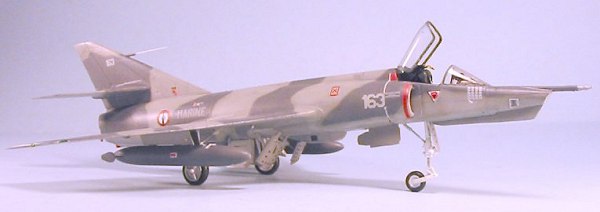 After cutting off
the alignment pins and sanding the fuselage centerline to get it nice and
smooth, the fuselage went together well, and only needed a light
application of Mr. Surfacer 500 to get rid of the centerline seam. Before
closing it up, I closed off the intakes with some Evergreen sheet, and then
added fishweights immediately behind the cockpit to insure it would nose
sit. I also extended the oleo of the nose wheel leg 1/8", replacing that
section with Evergreen rod, so that the model would sit nose-high enough to
look better than the relatively nose-low position the landing gear would
result in without modification.
After cutting off
the alignment pins and sanding the fuselage centerline to get it nice and
smooth, the fuselage went together well, and only needed a light
application of Mr. Surfacer 500 to get rid of the centerline seam. Before
closing it up, I closed off the intakes with some Evergreen sheet, and then
added fishweights immediately behind the cockpit to insure it would nose
sit. I also extended the oleo of the nose wheel leg 1/8", replacing that
section with Evergreen rod, so that the model would sit nose-high enough to
look better than the relatively nose-low position the landing gear would
result in without modification.
The wings attached to the fuselage without trouble; running cyanoacrylate glue in the seam top and bottom and letting it set naturally got rid of the seam and the gaps. The same was true with the horizontal stabilizers.
After gluing the windscreen in position and snapping the canopy into the closed position, the model was ready for the paint shop.
| COLORS & MARKINGS |
Painting:
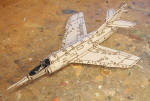 I first painted the
wheel wells and dive brake wells, as well as the landing gear legs and the
interior of the gear doors and dive brakes with Gunze-Sangyo “Off-White.”
When this was dry I masked those areas and then pre-shaded the model by
airbrushing black over the panel lines.
I first painted the
wheel wells and dive brake wells, as well as the landing gear legs and the
interior of the gear doors and dive brakes with Gunze-Sangyo “Off-White.”
When this was dry I masked those areas and then pre-shaded the model by
airbrushing black over the panel lines.
The model was painted with the new Xtracrylix paints, using Medium Sea Grey and Dark Sea Grey, following the camouflage pattern in the kit instructions.
 Xtracrylix are an
excellent new paint line from Hannant’s, with very accurate colors, that
dries semi-gloss - think of it as Xtracolor, only as an acrylic. I used
rubbing alcohol with the paint mixed 30% paint/70% thinner after some
experiments. I experienced some clogging in my Paasche H, which was cured
by opening the tip a bit and spraying it clear. With rubbing alcohol for
thinner, the paint dried to the touch within an hour here in Los Angeles on
a warm summer day with about 80% humidity. I would rate this paint as
being as good as Gunze-Sangyo or Tamiya, and equally easy to use.
Xtracrylix are an
excellent new paint line from Hannant’s, with very accurate colors, that
dries semi-gloss - think of it as Xtracolor, only as an acrylic. I used
rubbing alcohol with the paint mixed 30% paint/70% thinner after some
experiments. I experienced some clogging in my Paasche H, which was cured
by opening the tip a bit and spraying it clear. With rubbing alcohol for
thinner, the paint dried to the touch within an hour here in Los Angeles on
a warm summer day with about 80% humidity. I would rate this paint as
being as good as Gunze-Sangyo or Tamiya, and equally easy to use.
When the paint was dry, I gave the model a coat of Future and we were ready for decals.
Decals:
The kit decals are the typical crappy waste of time one has expected from Airfix up to recent years when they finally started making some decent ones. They went on with a coat of MicroSol, dried flat, didn’t silver, and from a distance of 12 inches the misaligned printing isn’t totally obvious. When they were dry, I gave the model another coat of Future.
| FINAL CONSTRUCTION |
Photographs I found on the internet of this particular Étendard show it to have been quite clean, so I did not weather it, but did give the model an overall coat of thinned Testor’s Glosscote, which resulted in a toned-down semi-gloss surface that looked accurate.
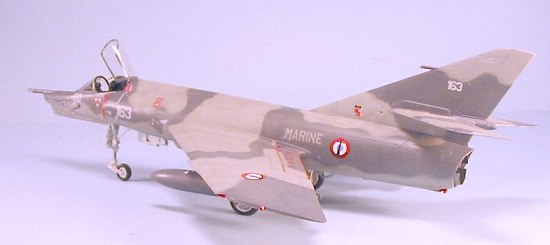 I attached the
landing gear and the dive brakes in the down position. I then learned from
a French source that the only time the Étendard was in this
configuration was during the pilot’s pre-flight walkaround - other than
that the dive brakes, and gear wheel cover doors are in the up position
other than when the gear is cycling up and down. To do the model in this
configuration would require gluing the relevant doors and dive brakes early
on in construction, sanding them down smooth with the surrounding fuselage
surface, then applying putty and sanding them smooth to get rid of the big
gaps, then rescribing them.
I attached the
landing gear and the dive brakes in the down position. I then learned from
a French source that the only time the Étendard was in this
configuration was during the pilot’s pre-flight walkaround - other than
that the dive brakes, and gear wheel cover doors are in the up position
other than when the gear is cycling up and down. To do the model in this
configuration would require gluing the relevant doors and dive brakes early
on in construction, sanding them down smooth with the surrounding fuselage
surface, then applying putty and sanding them smooth to get rid of the big
gaps, then rescribing them.
Having broken off the pitot from the leading edge of the vertical fin, I replaced it with a piece of .020 piano wire, which was unlikely to break again.
I glued the canopy in the open position and the model was finished.
| CONCLUSIONS |
A bad kit that makes into a nice model (with “some modeling ability required”) of a very interesting airplane that more than fulfilled its original specifications and went a very long way to making the Aeronavale one of the best naval air arms. If you like modern jets, the kit can be found for a very cheap price, and you’ll have a worthwhile addition to your collection. I have the very-similar Super-Étendard in the process of being built, so if I get a Mirage 2000 and a Rafale, I will have done all the Dassault jets except for the original Ouragan.
October 2004
Copyright ModelingMadness.com. All rights reserved.
Kit courtesy of my wallet!
If you would like your product reviewed fairly and fairly quickly, please contact the editor or see other details in the Note to Contributors.